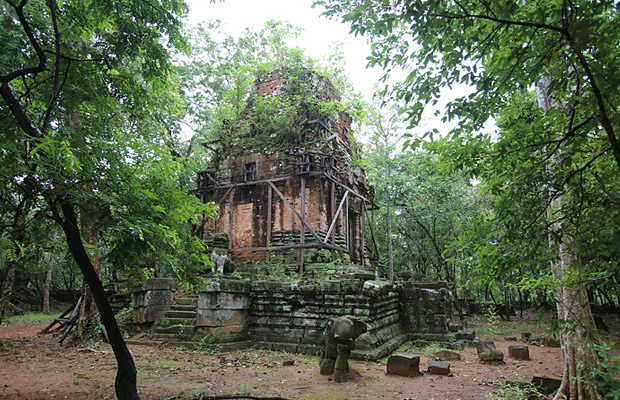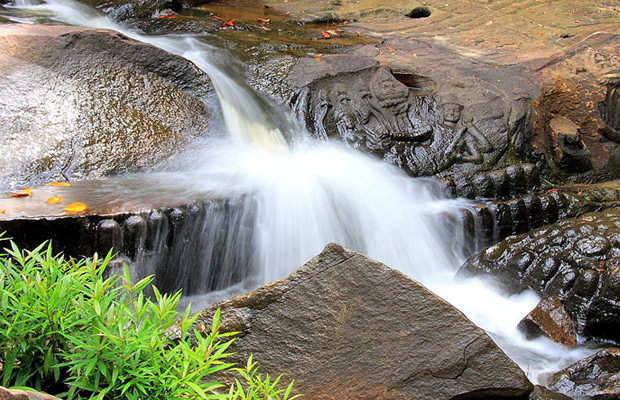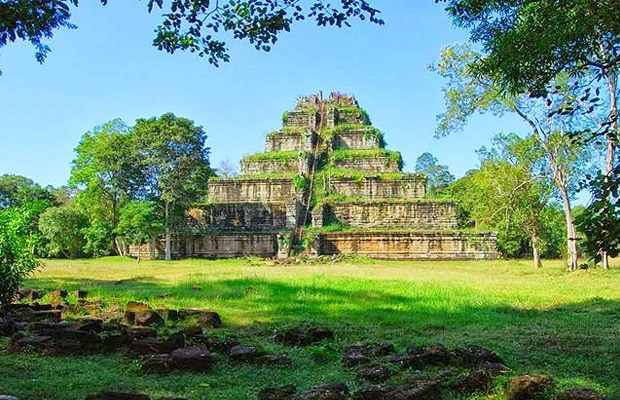Phnom Kulen
The Phnom Kulen mountain range is located 30 km north of Angkor Wat. Its name means "mountain of lychees". [3] There is a sacred site at the top of the hill. Phnom Kulen is considered a sacred mountain in Cambodia, of special religious significance for Hindus and Buddhists who come to the mountain on pilgrimage.
The Phnom Kulen mountain range is located 30 km north of Angkor Wat. Its name means "mountain of lychees". [3] There is a sacred site at the top of the hill. Phnom Kulen is considered a sacred mountain in Cambodia, of special religious significance for Hindus and Buddhists who come to the mountain on pilgrimage.
It also has an important symbolic importance for Cambodians as the birthplace of the ancient Khmer Empire, for it was in Phnom Kulen that King Jayavarma II proclaimed independence from Java in 804 CE. Jayavarman II initiated the cult of Devaraja to the king, [4]: 99-101 a cult linga, in what is dated 804 CE and declaring his independence from Java, of whom the Khmer had been a state of vassalage (if this is really "Java", the Khmer chvea used to describe Champa, or "Lava" (a lao kingdom) is debated, as well as the legend that it was previously held as a ransom of the kingdom in Java. See Angkor Civilization of Higham for more information on the debate). [5] During the Angkoran era, the relief was known as Mahendraparvata (the mountain of the Great Indra).
Kbal Spean is known for its sculptures representing fertility and its waters, which have a special meaning for Hindus. Just 5 cm below the surface of the water, more than 1000 small sculptures of linga are engraved in the bed of the sandstone river. The waters are considered sacred, since Jayavarman II chose to bathe in the river, and the river diverted so that the bed of stone could be carved. The sculptures include a stone representation of the Hindu god Vishnu lying on the serpent Ananta, with his wife Lakshmi at his feet. [7] A lotus flower protrudes from its navel with the god Brahma. The river then ends with a waterfall and a swimming pool.
Near these mountains is Preah Ang Thom, a sixteenth-century Buddhist monastery noted for the giant reclining Buddha, the largest in the country.
The Samré tribe was once living on the edge of Phnom Kulen, extracting sandstone and transporting it to the royal sites.
The Khmer Rouge used the location as a final fortress when its regime came to an end in 1979.
View Mores Temple Guide

Khleangs(North Khleang and South Khleang)
The Khleangs are two buildings of unknown purpose on the east side of Royal Square in Angkor Thom, Cambodia, located just behind the twelve towers of Prasat Suor Prat and separated by the royal route ...

Angkor Thom South Gate
The south gate of Angkor Thom is more popular with visitors as it has been fully restored and many of the heads (mostly copies) remain in place. The gate is on the main road to Angkor Thom from ...

Preah Khan Temple
Preah Khan Temple is located 2 km northeast of Angkor Thorn on the Grand Circuit. The temple was built in the second half of the 12th century AD in AD 1191 by King Jaya-varman VII, dedicating to his ...

Chau Say Tevoda
Chau Say Tevoda is a temple in Angkor, Cambodia. It is located east of Angkor Thom, directly south of Thommanon, through the Victory Path (before the previous date and post-dates). Built in the ...

Prasat Sras Damrei
Prasat Damrei is named for the elephants guarding the four corners of the shrine ('damri' is Khmer for 'elephant'). The temple was built in honor of Shiva, which was worshiped here as a linga mounted ...

Angkor Thom East Gate
The east gate of Angkor Thom was used as a location on the Tomb Raider, where the bandits entered the "tomb" pulling a giant polystyrene apsara. This is the most atmospheric of the gates of Angkor ...

Banteay Kdei Temple
Extensive monastic complex, largely unrefurbished, in the same style as Ta Prohm. It was originally built on the site of an earlier temple, and functioned as a Buddhist monastery under Jayavarman ...

Neak Pean Temple
Neak Pean (or Neak Poan) [2] (Khmer: ប្រាសាទនាគព័ន្ធ) ("The intertwined serpents") in Angkor, Cambodia is an artificial island with a Buddhist temple on a circular ...

Angkor National Museum
During the Golden Age of the Khmer Kingdom, one of the ancient civilizations of this world was being created. It was the origin of Khmer art, culture and architecture. These great inventions have ...

Kbal Spean
Kbal Spean is an archaeological site of the Angkorian era on the southwest slopes of the Kulen Hills, northeast of Angkor, in the Siem Reap district of Siem Reap province, Cambodia. It is situated ...

Koh Ker
Koh Ker (Khmer: ប្រាសាទ កោះ កេ រ្ដិ៍) is a remote archaeological site in northern Cambodia, about 120 kilometers (75 mi) away from Siem Reap and the ancient site of ...

War Museum
The only selling point here is that the museum encourages visitors to handle the old weapons, from an AK-47 to a rocket launcher. We're not sure what health and safety is, but it's a good choice for ...












